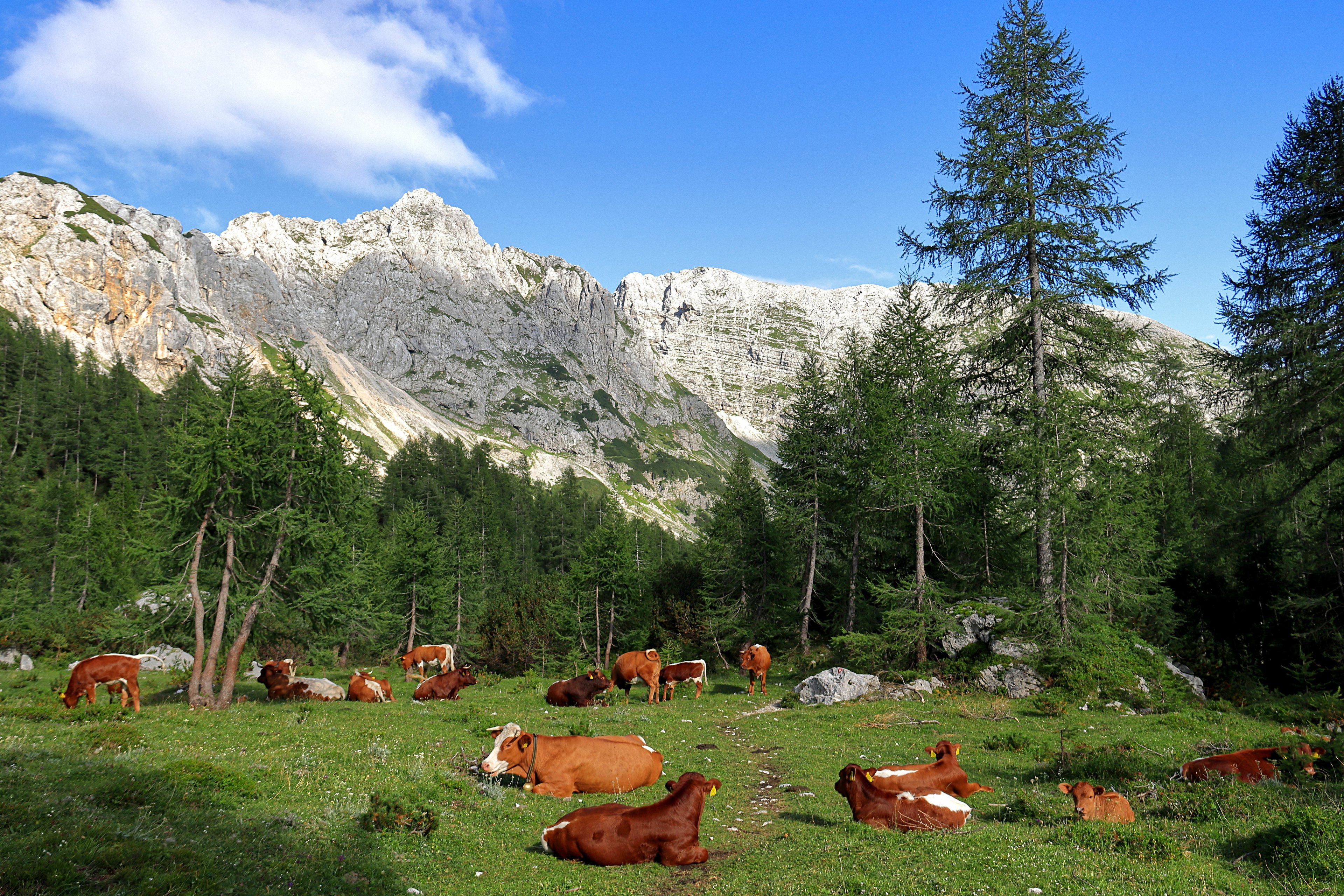Triglav National Park Hiking
Gain valuable insights into Triglav National Park hiking with our guide, from choosing the right season and trails to essential safety tips and equipment.

The Park
The Triglav National Park is a park with endless trekking possibilities. From easy treks through stunning glacial valleys with picturesque alpine villages and crystal-clear rivers, to more challenging hikes through authentic alpine pastures, walking on panoramic ridges looking down on pristine mountain lakes – everyone can find a trail for himself here. Look below to find your route, when to go and how to prepare.
Seasons for Hiking
If you want to go hiking through the Triglav National Park, you must choose the right time of year according to your desired type of tour.

Lowland tours and undemanding hikes are possible throughout the year, and most do not require a professional guide. The best time for such hikes is in late spring when the weather is not too hot, nature is in bloom, and you can see the beautiful contrast between the green valleys and the white peaks towering over it.
The early autumn is attractive because of its beautiful colours, pleasant temperatures and stable weather. When the first snow falls and autumn starts turning into winter, the conditions in the mountains become much more demanding. It’s the time only the most experienced go into the mountains alone. The snowed-over terrain demands more experience, special equipment, and the proper techniques to be experienced safely and enjoyably.
Summer, the most popular season for trekking, is when the temperatures are higher, so most lowland hikes run through forests, gorges or alongside bodies of water, like the Martuljek waterfalls, Mostnica Gorge or the Soča River. That means that most can be easily combined with refreshing water activities like rafting, canyoning and kayaking. June, July and August are the best months for hiking in higher mountainous terrain, as the snow has mostly melted. An early start is a must since temperatures are more bearable in the mornings and unpredictable afternoon storms are avoided.

Preparing for a Triglav National Park hike
What to pack mostly depends on the chosen tour. Striking the right balance between packing too much or too little is an art in itself. Pack too little, and you can get yourself in trouble with not having something crucial on you in the mountains. Pack too much, and you’ll feel the effect that will have on your shoulders and your overall tiredness, which can make the hike less enjoyable and also less safe, especially towards the end. An experienced guide is always the best person to turn to for advice on which equipment to bring.
In general, you should take some extra warm layers of clothing, even during warm summer months. Other musts are a wind-stopper jacket and some hiking shoes/boots with excellent grip.
There are many areas within the Triglav National Park where phone reception is questionable, which means GPS might not work. Maps for navigation should therefore be stored in advance and phone battery saved in case of mishaps. The emergency number to call in Slovenia is 112.
On steeper, exposed and overall more demanding rocky trails, a helmet is recommended, so the crumbly limestone rock doesn’t break off and injure your head. That kind of debris can be easily triggered by a hiker in front or a passing mountain goat.
Don’t forget to bring enough water supplies, especially on routes without any tree cover. Water sources in the mountains are drinkable, but scarce because of the karst terrain. High-calorie food should also be packed, so you can replenish your energy when needed if there are no huts nearby.
Late spring and winter is a whole new beast, as crampons, ice axe and maybe even avalanche safety gear is needed. Snowy patches can sometimes stay well into the summer. Slipping is the most common type of accident in the mountains. It mostly occurs due to inadequate equipment, exhaustion and/or not knowing the terrain.
We therefore strongly advise that any demanding or longer intermediate hikes are ventured on with a professional local guide.

Popular Hiking Trails in the Triglav National Park
There are more than 800 kilometres of hiking trails in the Park, that are begging to be explored and reveal their natural treasures. Here are some of the highlights.
The Soča Trail
The 25-kilometer trail leads you along the emerald green Soča River – from its source, leading you through the peaceful sections of the Trenta valley, crossing the footbridges hanging over the river and ending up in the picturesque town of Bovec. It is also a part of the much longer Alpe Adria Trail, that connects the Austrian and the Slovenian Alps with the Italian Adriatic coast.
Mostnica Gorge
This undemanding but lovely trail follows the 2-km gorge of the Mostnica River above the village of Stara Fužina. The path runs along crystal river pools, which are sometimes up to 20 metres deep and later on continues to the scenic Voje Valley. Be on the lookout and don’t miss the gorge’s signature formation, a rock in the shape of an elephant’s head.
Hiking above the Pokljuka Plateau
The endless forests of the Pokljuka Plateau are an excellent starting point for Triglav National Park hikes, since you start at a higher elevation and can reach panoramic peaks, that would otherwise take more time to reach. That’s what also makes it a popular hut-to-hut starting point, while from one day hikes, Viševnik is the easiest and the most panoramic.
The Seven Lakes Hike
Some say the Seven Lakes or the Triglav Lakes Valley is the heart of the Triglav National Park, as it was also the first to be protected. The hike there takes you trekking across many authentic alpine pastures and into the valley of crystal clear mountain lakes. You can hike through the valley in one day, but it is best to include it as a part of your multi-day mountain tour. It is one of the biggest highlights of the Park, that’s why we included it into most of our Hut to Hut tours we prepared.

Mt. Triglav
For the more experienced hikers and those who want a bigger challenge, there is no better choice than a climb of the highest mountain in Slovenia and the namesake of the Park. Triglav is one of the country’s most important symbols and nobody becomes a true Slovene until they reach its peak. For an all-around experience, include it in your 3-day Hut to Hut Tour. If reaching the peak is your main goal, check out other Triglav Tours.
Juliana Trail
This long-distance trail takes you around the Julian Alps of Slovenia. It leads through scenic valleys, mountain passes, along rivers, through picturesque villages and towns. It allows you to discover the beauty of the Julian Alps region, without venturing too high into the mountains.
Experience the beauty of the Triglav National Park on some of the best Hut to Hut Hiking Tours.

Expert Local Guides
Our professional guides know the local terrain and are trained to make this once-in-a-lifetime opportunity both safe and enjoyable.

Hassle-Free
We handle route planning, accommodations, transfers, and anything else you prefer not to deal with, so you can enjoy a carefree hike.

Tried & Tested Adventures
Only the best hiking adventures in Slovenia, cherry-picked by our local team with an in-depth knowledge of the region.

Book with Confidence
We are a financially protected company, fully bonded and insured, keeping your money safe and allowing you to travel with confidence.

Unbeatable Support
Our 24/7 customer support is where we show our passion, bringing you a better experience by making your well-being our number one priority.

